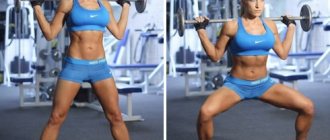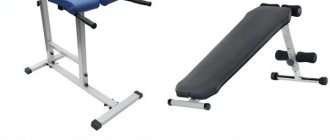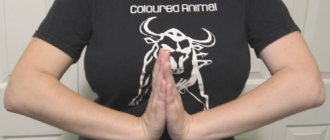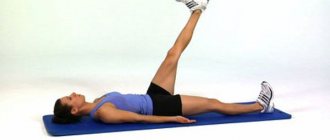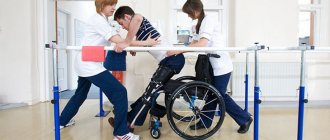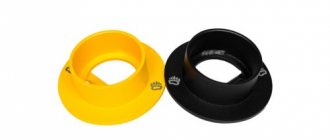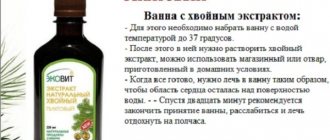Exercises for pumping up your fingers
The record of Hermann Georner, set back in 1920, is considered a feat of strength. He held a weight of 327 kg in a deadlift with one hand! At the same time, the athlete used a lock grip: the thumb was above the others. This grip is still used by professional weightlifters today.
So, what are the techniques and techniques for strengthening your fingers?
- Street horizontal bar. If you hang on the crossbar for a long time, your tenacity and endurance increase.
- Holding heavy dumbbells with your fingers. An excellent result is achieved when the hand is rotated while holding a dumbbell. Gradually, you can increase not only the rotation time, but also the load by attaching “pancakes” to the dumbbell.
- Rotating two balls in the palm of your hand helps develop motor skills and dexterity. This exercise can be used as a warm-up before more complex loads.
- A hand expander is the most effective remedy. It can be used at any free moment throughout the day. The expander is convenient due to its small size and weight, which allows you to take it with you to work, on the road, or on a business trip. You can work on it by applying static and dynamic loads on the finger muscles.
- Hanging on the horizontal bar. This should be done with a “reverse grip” and on the fingers.
- Push ups. Traditional push-ups should be done on your fingers, not your palms. This is the most difficult exercise, which should be the final one after the stage of training with an expander or horizontal bar.
Developing grip strength
There are several types of grip strength. Each of them has its own development methodology. But they have one thing in common: a regular increase in load volume. So, let's name 4 types of grip strength:
- Compressive. It is equivalent to a firm handshake.
- Holding. This is the statistical strength of your finger and hand muscles to grip an object and hold it for a long time.
- Plucked. This type is characterized by the ability to hold something between the palm and a fairly strong thumb.
- Wrist strength. It is comparable to arm strength in general. This is the ability to hold an object with your hands for a long time.
So how do you develop each of these types of grip strength?
- The compressive force is developed by the expander. In stores, these sports attributes are sold with different resistances. Of course, first you need to purchase an attribute with the least resistance, and after 2-3 weeks of training and pumping up your fingers, switch to a stronger resistance of the expander.
- Trains holding strength by holding dumbbells hanging. Progression of the load is carried out by adding “pancakes”. You can make the exercise more difficult by swinging the dumbbell. In this case, wrist strength will also develop.
- Pinch strength training. Even with excellent grip strength, you may have a hard time holding something with your fingers. After all, plucking is the strength of your thumbs. Holding two “pancakes” with them is a simple method of developing this type of grip. Add together these attributes of the smallest weight and hold, gradually increasing the time and weight of the “pancakes”. An indicator of colossal strength is holding two twenty-kilogram “pancakes” with your fingers. It's very hard.
- Wrist workout. The most effective exercise for developing wrist strength is the dumbbell wrist curl. To perform the exercise, you can place your forearms on a bench and lift and lower dumbbells. Another way to train your wrists is to rotate dumbbells back and forth and clockwise in your straight arms. Elbows should not work!
So, the fingers, the hand as a whole, and the wrists can also be pumped up. Do not forget about gradual and increasing loads. Please note that your hands will shake and hurt. But this temporary phenomenon is compensated by successes!
ARM TRAINER mobile version
BUD - hand trainer.finger trainer
after a stroke.
| Please note that the “Bud” simulator after a stroke is equipped with WHITE Velcro. To extend the service life, the edges of the Velcro sections are subjected to heat treatment (slight melting). The “Bud” finger trainer will always be at your fingertips; at any time you will be able to restore movement in your hand and fingers. As a rule, training on a simulator have a positive effect not only on the fingers and hand , but |
The “Bud” simulator for the rehabilitation of fingers is equipped with motors with a gearbox made of metal moving elements, which ensures reliable operation of the simulator even for long-term recovery after severe injuries or stroke. The safety of use is due to the low supply voltage, which eliminates any problems with the use of the “Bud” hand simulator.
Particular attention was paid to the long service life of the device, because... recovery may take more than one or two months. The severity of injuries and the severity of brain damage during a stroke significantly affect the time it takes for hand mobility to return to normal. For “collars” (injury of the cervical spine), for long-term use of the finger simulator, the “Bud” simulator may be suitable.
CALCULATOR
— Recovery, even after a moderate stroke, takes several months, rent of any exercise equipment is 700 rubles per day.
This will amount to at least 40,000 rubles in two months! We offer you a simulator for 20,000 rubles, which will serve you faithfully for a year or more, helping with recovery!!! Comprehensive recovery of fingers after a stroke, after injury or surgery.
It is very important to prevent your hand from “withering” and your fingers forming into a fist. After the acute phase of a stroke, when a period of stabilization begins, of course, you need to monitor your blood pressure and follow doctors’ orders, but we must not forget that all the muscles of the body that are not “loaded”, that do not work, begin to degrade and lose muscle mass. Without movement, joints become “overgrown” with salt deposits, which will sooner or later begin to stiffen. Without constant training, the tendons slowly but surely tighten, become shorter and pull the fingers along with them, which inevitably, without training, SLOWLY, IMPOSSIBLY will curl into a fist. Changes occur smoothly and slowly, it can be compared to the growth of hair or nails. We SUDDENLY notice that we need to do something with our hair, we need to cut our nails. And in worries and problems, we put off, like, not very important, not primary problems for a later time. It is precisely at this time that the hand slowly loses its properties, and the functions of a healthy hand degrade! But she didn't have a stroke, did she? Why does the hand curl into a fist? Why does my brush sag? Why, instead of an instrument of comfort, we end up with, alas, a painful, painful part of the body? These are, of course, the consequences of a stroke! Which damaged the brain, but the stroke left the arm WITHOUT MOTION
and it (the hand) began to
slowly fade away.
Try not to reassure yourself: “We must wait until the hand “thaws”, “moves away”, “comes to life”!” We need to really assess the situation! What is important here is the OPINION OF A DOCTOR, who will be able to more accurately understand and assess the dynamics of recovery. If recovery after a stroke is dynamic and relatively fast, then of course you can and should just wait
, if possible, massaging your hand, periodically develop your hand with exercises.
It’s another matter if you notice signs of clenching your fingers into a fist.
, fingers
are difficult to straighten
. These are the first signs of insufficient finger movement and insufficient dynamic load.
The hand trainer will really keep your fingers in normal working condition. And not just fingers. After all, the fingers are controlled by the muscles that are located between the hand and the elbow, i.e. hand trainer for fingers
will develop both the fingers, but also the hand, and the muscles up to the elbow. Each flexion-extension cycle of the arm exercise machine affects the muscles, and each time the muscles send an impulse to the brain, reporting their movement. Each session on the simulator is multiple attempts by the fingers to “reach” the brain, repeated “demands” on the brain so that it “notices” the hand and fingers and begins to control them.
The site presents two hand trainers for use at home. These simulators are as simple as possible, safe, and, most importantly, ten times cheaper than similar devices for recovery after a stroke.
No need for a massage therapist, a qualified specialist! Any loved one can help fix the arm in the simulator and conduct a rehabilitation session. In any convenient position for the patient, you can exercise on the simulator. The main condition is the patient's comfort.
The “Bud” finger trainer works on four fingers, providing the maximum possible range of extension and flexion of the fingers. If the resistance of the fingers is more than 1 kg, then the machine will stop and start moving in the opposite direction. The thumb is also attached to the hand trainer
at an angle close to 90 degrees. This is a passive, but also very effective load on the thumb.
The Petal hand trainer trains the thumb exclusively. “Swings” the thumb with the maximum possible amplitude. The “Petal” finger trainer for fingers after a stroke or injury should be given attention to those who have the greatest problems in finger restoration with their thumb. Thumb rehabilitation The Petal simulator will most likely be in demand after surgery on the thumb or injury. On the “Petal” simulator, you can specify, when ordering, the force that the hand trainer exerts on the finger (the amount of force cannot be changed during training! Or it is specified when ordering).
Recovery after a stroke of a paralyzed hand (fingers).
The compression-decompression cycle is 14 seconds, or 257 times per hour.
The simulator will never get tired and will gently train your fingers.
The “Bud” simulator will not extend or bend the fingers to the full amplitude, in case of severe contracture (“shrinkage” of muscles and joints). But with each lesson, if the “rigidity” has not become irreversible, the fingers will be softer, the arm will open more.
Stroke Arm Test (click to check arm condition)
Pay attention to the “softness” of the hand and the flexibility of the fingers!!! Difficulty extending the fingers is a clear sign of “drying” of the tendons and “ossification” of the joints. This occurs due to lack of movement of the fingers. Even if there is no sensitivity, the fingers must be forcibly bent and unbent every day, trained.
| Attention! The glove and fixing “Velcro” on the “Bud” exercise machine are WHITE!!!!! |
| Restoring mobility after a stroke fingers are usually put aside “for later.” Stroke problems are very serious! And the flexibility of the hand and fingers begins to worry already at the stage of stabilization of the situation. As a result, the fingers cannot be straightened even with some force. Why did this happen? It’s just that in everyday life we don’t notice how much time our fingers spend in the “exercise”. We constantly bend and unbend them, load them with work, force them to touch, share sensations of tactility. In the state after a stroke, of course, there is nothing like that! And the fingers “stagnate”, “ossify”, the joints lose flexibility. What can and should be done? Perform a hand massage , fingers, therapeutic exercises, | Exercise machine for the arm after a stroke on one arm. Made either for the left or right hand. Price 20,000 rub. Attention! During the manufacture of the simulator, design changes are possible. (This is only 8-10 sessions of a massage therapist, i.e. payment to the massage therapist for one to two weeks! And recovery after a stroke can take at least several months! A simulator for recovery after a stroke is the development of joints and muscles at any time convenient for you time! The simulator will gently bend and straighten your fingers throughout the entire session, morning, afternoon, and evening.) The “Bud” post-stroke exercise machine is powered by a 220-volt network and is absolutely safe from an electrical point of view. Galvanic isolation guarantees and completely eliminates the entry of dangerous voltage on the simulator and on the patient. |
Attention! Evaluate whether it is possible for you to use the “Bud” simulator!
The hand should be “
SOFT
”, i.e.
Irreversible changes
in the ossification of joints and muscles yet If with outside help, albeit slowly, you can still straighten your fingers, then time has not yet been lost and the use of the “Bud” simulator is still possible. If, after a stroke, self-healing of the hand does not occur (the fingers gradually clench into a fist), then in order not to lose the functionality of the hand, either many hours of massages or the “Bud” simulator or similar ones are needed. With use SEVERAL HOURS A DAY!
Frequently asked question: “Is there a guarantee that massage or the BUD hand exercise machine will help?” - The answer is very simple! — There are real positive dynamics for almost everyone. Of course, the smaller the area of brain damage, the more noticeable the result literally in the first weeks of training. (The necessary condition we are talking about is at least three sessions a day for 40 minutes!!! and you will see the result!!!) With deep brain damage, of course, more time is required for recovery! And even in such cases, it is necessary to help the arms and legs that are not yet working with exercise equipment or massage. We must not allow the fading of vitality and physical condition in “numb” hands and feet. In no case should the situation be brought to the point of “ossification” of an arm or leg, because Unfortunately, it is almost impossible to return a hand that “hangs like a whip with fingers tightly clenched into a fist” to a “working” state. Stroke Trainer Gives Stroke Recovery Function
,
a support function after a stroke
, but a stroke is a very serious and insidious disease and, unfortunately, no one can give a guarantee of recovery, and we honestly say this!
The positive dynamics of the “Bud” simulator increases significantly
, if each training session asks the patient
to focus on the sensations that accompany the cycles of flexion-extension of the fingers.
(This information was received from several independent customers of the simulator.)
Do not distract the patient with any additional “irritants”
!
The brain was severely damaged after a stroke, help him! Let the patient, when using the “Bud” simulator after a stroke, think only about the mobility of his fingers
, let
him “listen” only to the thin nerve that connects the brain and fingers
.
Let the training be accompanied by the thoughts that this is not a simulator, but I am bending and unbending my arm!
From consolidating the impulses from flexion-extension of fingers in the brain to the ability to confidently control your fingers - there is only one small step left. But don't quit! Don't miss sessions! Reinforce and consolidate the results achieved.
When contracture begins (fingers are difficult to straighten), the “Bud” simulator will not injure the joints! Will train the hand at a SMALL AMPLITUDE
, in which the hand is not injured.
OVER TIME, GRADUALLY, the “softer” the hand becomes, the more it will open on the simulator. The “Bud” trainer will help you develop your arm, but NOT INSTANTLY!!!! Serious diseases cannot be cured “in one go”
! To overcome the disease, to achieve results, you MUST put in a lot of effort, be patient, and never lose faith!
IF YOU DO NOTHING, THERE WILL BE NO IMPROVEMENT.
Additional Information. When using the “Bud” simulator after a stroke, a DECREASE in arm swelling was observed. This is probably due to the increase in blood flow through the capillaries, which is activated during exercise on the simulator.
| How to secure your hand in a training glove. The finger holders should be as close to the fingertips as possible. In this case, the maximum amplitude of opening the hand will be achieved, all finger joints will be involved in the work. |
The “Bud” post-stroke simulator replaces the hands of a massage therapist and significantly reduces the cost of recovery sessions. The simulator has foreign analogues, for example ARTROMOT®-F
, which is positioned as a simulator for recovery from hand injuries and “
various contractures
.”
Cerebral
contractures can occur after brain damage.
A powerful effect was revealed not only on the joints and muscles of the hand, but also on the elbow muscles and muscles of the shoulder sector. The impulses sent by the affected brain to the arm in the initial stages of recovery have a chaotic, “blind” sending of commands to compress and unclench the muscles of the entire arm. PAY ATTENTION to the tension in the muscles of your ENTIRE ARM. If, when using the exercise machine, any muscle of the arm tenses and DOES NOT RELAX, then this is a clear sign that the connection between the brain and the muscle is NOT LOST!!!! This is a VERY GOOD SIGN
!!!
Such moments should not be missed, they are the most important in recovery!! And this time you MUST, MUST, not miss the moment and do additional exercises for flexion-extension of the arm at the elbow
(hold your elbow and bend the wrist away from you and towards you until the tension in the muscle disappears, or hold the wrist and raise and lower the elbow until it disappears tension in the muscle). In this way, you “explain” to the brain which impulses it should issue to compress the muscles and which to unclench. The brain must “learn”, remember, and learn again which impulses are responsible for what. (The brain learns to control the body again.) The initiator and catalyst for the process of restoring connections between the brain and muscles of the entire arm in this case is the “Bud” post-stroke simulator.
| We present to your attention a response from a website selling an analogue of a finger simulator for recovery after a stroke. https://osteocure.ru/tovar/apparat-artromot.html The “Bud” simulator for finger recovery after a stroke is positioned not only for use after a stroke. |
Feedback on the use of the simulator after a stroke “BUTON”:
“A completely immobile arm, when trained with the “Bud” simulator after a stroke twice a day for 40 minutes, became “obedient” to the patient in the shoulder joint!
Restoration and mastery of the motor functions of the hand began not from the fingers, but from the shoulder.” Those. the nerve receptors stimulated by the simulator helped structure the control of the shoulder and elbow muscles. Another review:
“A year passed after the stroke, the arm felt touch, but
was completely motionless from the shoulder joint
.
Using the “Bud” simulator for one month, “muscle fatigue” appeared in the arm, the patient began to feel the muscles of the arm.” Those. the fading muscles and reflexes of the hand began to recover, informing the brain not only about the EXISTENCE of
the hand, but also provoking painful sensations to intensify movement in the hand itself. It has been noticed that in some cases, when training on the “Bud” simulator, spasms of individual arm muscles begin. It's not scary! This is good! Because The interaction between the muscles and the brain is restored, the brain is “trained” - what impulses should be given and where so that the hand works like a healthy one. Of course, you don’t have to endure pain! You need to pause the activity and massage from fingers to shoulder to remove the spasm. Exercises on the “Bud” simulator will lead to the brain “understanding” what impulses tense and relax a particular muscle. After repeated “explanations”, the brain will have no choice but to control the newly “found” muscles, arm, fingers. This is our goal!
The “Bud” simulator for restoring the mobility of fingers after a hand injury, finger injury, or joint damage. After surgery, it is possible to use the “Bud” simulator to prevent dystrophy of the arm muscles and overcome painful manifestations when flexing and extending the fingers. The “Bud” post-stroke exercise machine is a very strong stimulator of brain activity. A huge spectrum of impulses comes not only to the fingers, but also to the entire limb. Sensitive monitoring of excitation, muscle tension in the arm, and additional exercises for flexion and extension of tense muscles help the brain return dynamics to the affected arm in a shorter time.
| ATTENTION! THE EXERCISER IS EQUIPPED WITH A GLOVE WITH VELcro!!! Exerciser "Bud" for two hands. Exercise machine for spinal injuries. Archive video. Posted for information on how to use the two-handed exercise machine. Price 23,000 rub. Attention! During the manufacture of the simulator, design changes are possible. (This is only 10-12 sessions of a massage therapist, i.e. payment to the massage therapist for one to two weeks! And recovery after a stroke can take at least several months! A simulator for recovery after a stroke is the development of joints and muscles at any time convenient for you time! The simulator will gently bend and straighten your fingers throughout the entire session, morning, afternoon, and evening.) The “Bud” post-stroke exercise machine is powered by a 220-volt network and is absolutely safe from an electrical point of view. Galvanic isolation guarantees and completely eliminates the entry of dangerous voltage on the simulator and on the patient. | For rehabilitation after a stroke, massage and therapeutic exercises for the fingers can and should be done several hours every day ! The real effect on the fingers and hand is noted by almost everyone who has used “Bud”. Any impact on the affected areas of the body is very useful for recovery after a stroke! The simulator after a stroke for the hand, fingers creates a tactile signal in the nerve endings and, if it can “break through” to a part of the brain that was not damaged by the stroke, sensitivity will appear! You will be able to move and control your hand and fingers! We must not allow the joints on the fingers to “ossify”! (On one of the forums, the doctor suggested the total time for therapeutic finger exercises - four hours a day!) |
A sign that you need to be more active in restoring your arm can be pain in the shoulder joint. SHOULDER JOINT LOSS
occurs due to the constant impact of a severely paralyzed arm on the joint. Gravity pulls the arm joint out of the shoulder. Unfortunately, this leads to severe pain, but this is not the worst thing! The fact is that there is a real reluctance, based on pain, to no longer make any attempts to recover. The arm will not be pulled out of the shoulder joint only when the arm-shoulder muscles support the arm and balance the force of gravity. It is necessary to rapidly use various means to restore the performance of the muscles of the shoulder and arm. And not the last resort may be the “Bud” simulator for recovery after a stroke. Impulses from flexing the fingers have a positive effect on the passage of signals to the brain throughout the entire arm, including the shoulder areas. It is simply necessary to influence all possible areas of the paralyzed body, to try to trigger the “paralyzed muscle-brain” interaction mechanism. The human body is very strong and viable, but it is necessary, and sometimes even necessary, to help the recovery processes with massage and exercise equipment.
HOW TO TAKE MEASUREMENTS
| The “BUDON” finger trainer after a stroke develops four fingers of the hand. Stay in a position that is comfortable for the patient for exactly as long as you deem necessary. The duration of rehabilitation of the hand and fingers after a stroke is determined by the severity of the patient’s condition and can last for several months. The BUD simulator bends and straightens the fingers as gently as possible up to a certain effort, in no case creating any pain for the patient. Please note that the electronics will bend and straighten your fingers exactly at the angle at which your fingers bend . An option is available to fix the working position of the simulator. |
| Option 1. The simulator is installed on a table or any convenient flat surface. Exercise machine after stroke can work IN ANY POSITION, but one condition must be observed - THE FRAME SHOULD NOT TOUCH ANYTHING WHILE MOVEMENT. |
The “Bud” finger trainer after a stroke will help develop fingers that are already susceptible to paresis (paralysis). The simulator automatically tracks the force with which it bends and extends the fingers. When a certain resistance from the fingers is reached (the joints do not allow either the fingers to be completely bent or fully extended), the simulator after a stroke for restoring the fingers begins to move in the opposite direction. Thus, the simulator tracks in each phase
at what angle can you bend or straighten your fingers? The force of the simulator for fingers after a stroke is chosen in such a way as not to cause distress to the patient in any way! The principle, the ideology of the simulator is that you can (and should) do a LOT of flexion-extension cycles! And, if the cycle ended with incomplete flexion or extension, nothing bad happened! The whole process is aimed at the fact that after 10,100, 1000 cycles the fingers (joints) should become more flexible and the post-stroke simulator for the fingers will closely monitor the positive impact and more complete extension of the fingers.
Medical research has established that nerve endings try to “break through” to brain neurons through neighboring areas that were not damaged during a stroke. Therefore, the movement of the fingers, repeated flexion and extension is another and very good positive effect on the entire body, which can be “noticed” by the brain
.
| A simulator after a stroke for restoring fingers. Two-handed option. Stands on both sides allow you to install the exercise machine after a stroke for a neck or spinal brace for both the right and left arms. |
Directions for use: Consistently! 1-Turn on the finger simulator after a stroke. (insert the plug into the power socket). When turned on, the simulator will take its original position. (fully open hand). 2-Press the button and set the finger support lever to a comfortable position for placing your hand on the machine. (Pressing the button turns the lever movement on or off.)
ATTENTION
3-You must try to secure all four fingers
at the very tips;
it is with this fastening that
the simulator will have maximum functionality
. If during the exercise the fingers (especially the little finger) fly out of the fastening, then, of course, you need to fasten the fingers a little deeper. The position of the hand during training and the depth of attachment of the fingers should be as comfortable as possible and selected individually. Practice has shown that ALL patients find a comfortable position for the arm and exercise machine for training.
| 4-Secure the hand with three elastic clamps so that the wrist is pressed against the table during operation of the simulator. Don't squeeze too hard!!! |
5-Secure the thumb so that it does not interfere with the movement of the finger simulator after a stroke. 6-Press the cyclic action button of the exercise machine.
After the procedure, press the same button to turn off the finger trainer after a stroke.
The weight of the simulator after a stroke for the fingers is 1 kg.
Within 6 months you can contact us for FREE troubleshooting of the simulator.
.
Provided that the simulator was operated under normal home conditions (the simulator should not be deformed, you yourself should not correct anything, either electronically or mechanically).
You provide us with a simulator - we fix it for free.
Shipping, when ordering, in case of breakdown is carried out only at your expense
! (In order to avoid unnecessary expenses, we recommend using SELF-PICKUP.)
Delivery methods throughout Russia:
Russian Post - cash on delivery. (You simply order the “Bud” simulator and, in about a week, you will receive the package.)
Pickup from Moscow. (You yourself will be able to see the excellent, effective functions of the simulator.) If not you yourself, then your relatives and friends will probably come to Moscow. Ask them to help bring an arm exerciser after a stroke.
The positive effect is confirmed even by the fact that a healthy person
, who has used the BUD simulator for at least 15-20 minutes, feels
a clear surge of energy
in the hand,
tone increases
(as if an intense massage was performed!!!).
This information is for informational purposes only.
and under no circumstances is it a public offer.
The finger post-stroke exerciser is designed for home
! Very easy to use.

